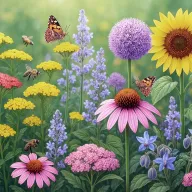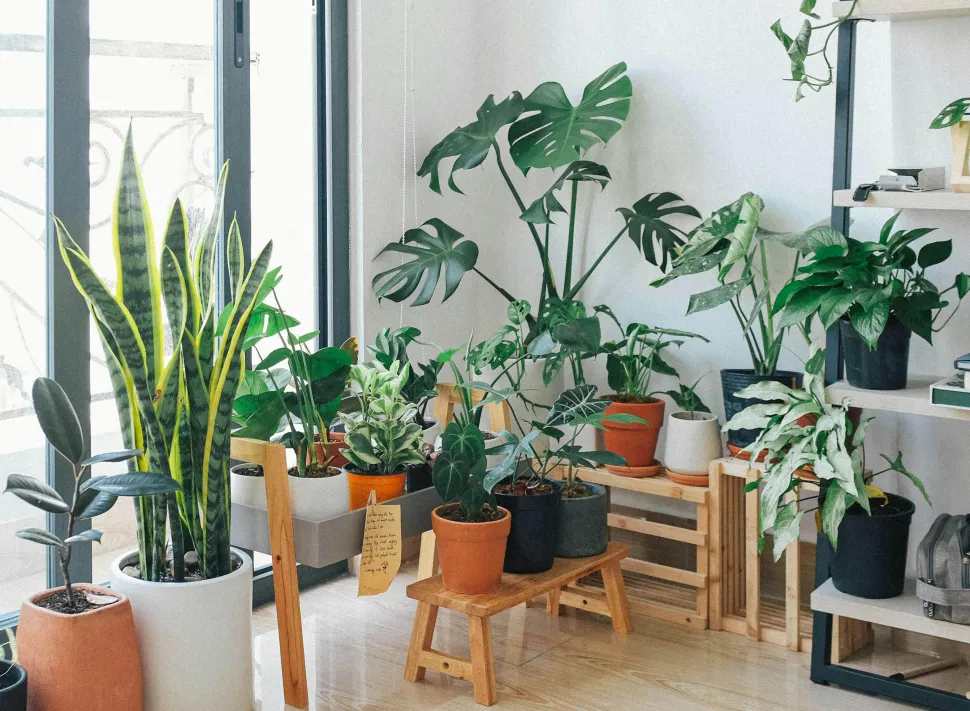
These plants with incredible foliage
Article for :All parent plants
Are you a decorating enthusiast who'd like to give your home a contemporary touch, but can't afford a designer piece? Head for your favorite florist. Thanks to our selection of shrubs and plants with graphic foliage, it only takes a few dozen euros to give your living room a makeover and expand your collection.
#1 Begonia rex
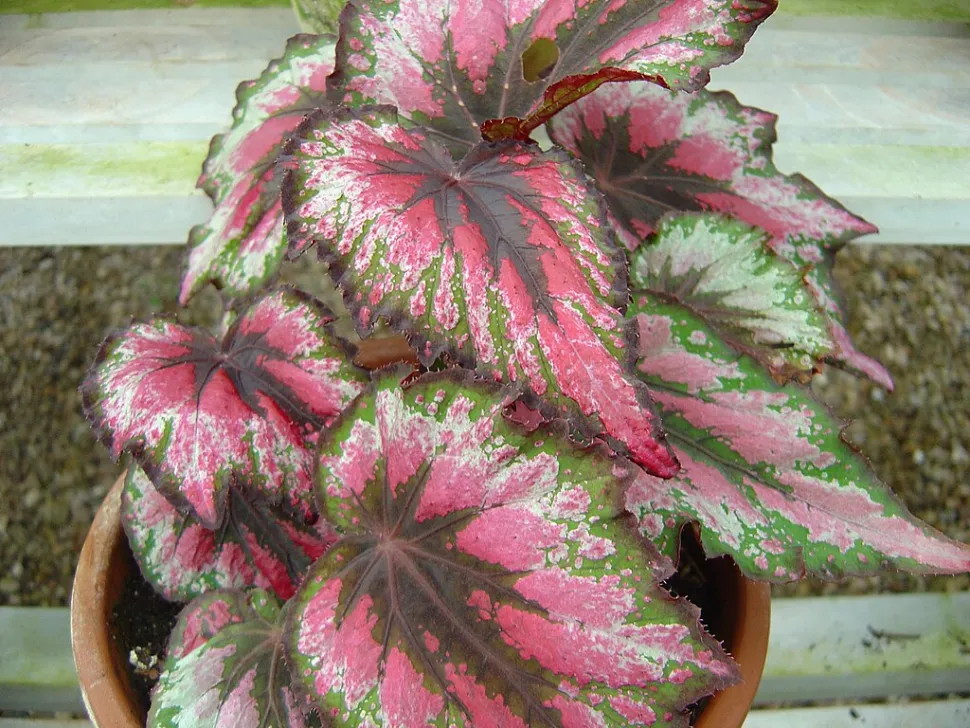
With its green and pink leaves, the 'Zurich' cultivar isn't bad either - Photo by Mininain / Wikipedia
Begonia rex all have very graphic foliage. It's hard to choose between the contrast of green and black on the leaves of Begonia 'Beleaf' and the soft pink and pale green on the limbs of Begonia 'Maui Sunset'.
Royal Begonia 's colorful foliage has to be earned! The plant is fragile and does not tolerate excess water. To avoid killing yours, wait for the substrate to dry out by at least three centimetres. Then water sparingly, so as not to drown the fine roots.
#2 Caladium bicolor
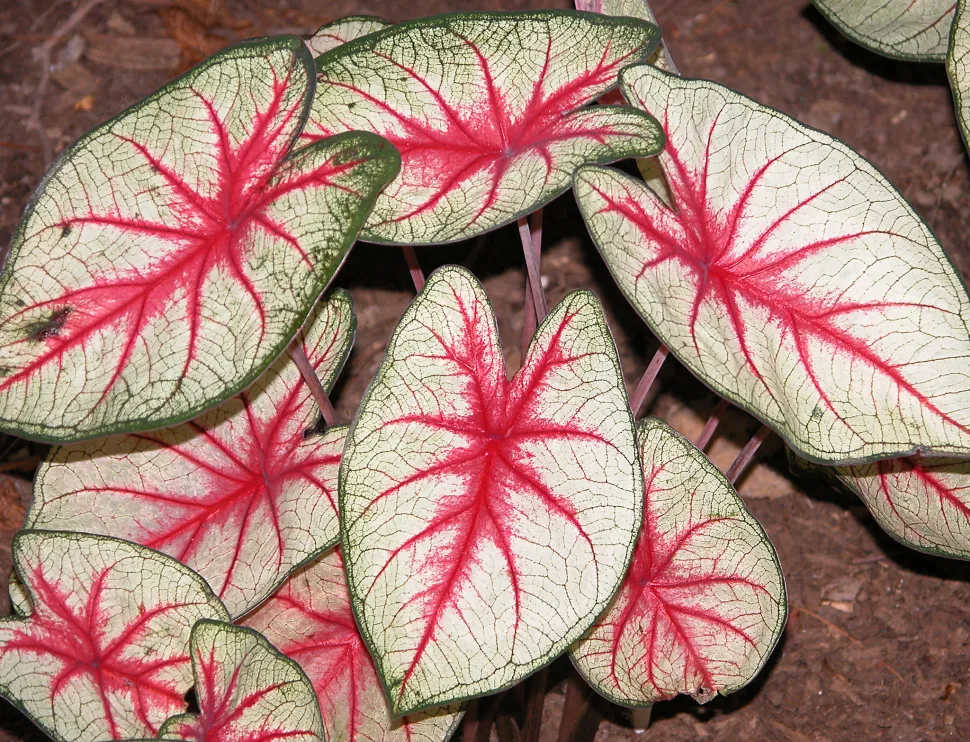
I promise you, this plant really exists. This is not an image generated by artificial intelligence - Photo by Carl E. Lewis / Flickr
White, pink or green. With regular patterns or Jackson Pollock-style splashes... There are two-tone Caladiums to suit every taste. But all share the same delicacy, which gives their foliage an unreal air.
Unfortunately, you can't decorate your apartment all year round with Caladiums. In autumn and winter, these plants go dormant. All that's left are bulbs, which you need to keep dry and out of the sun.
#3 Mother-in-law's tongue (Sansevieria trifasciata)
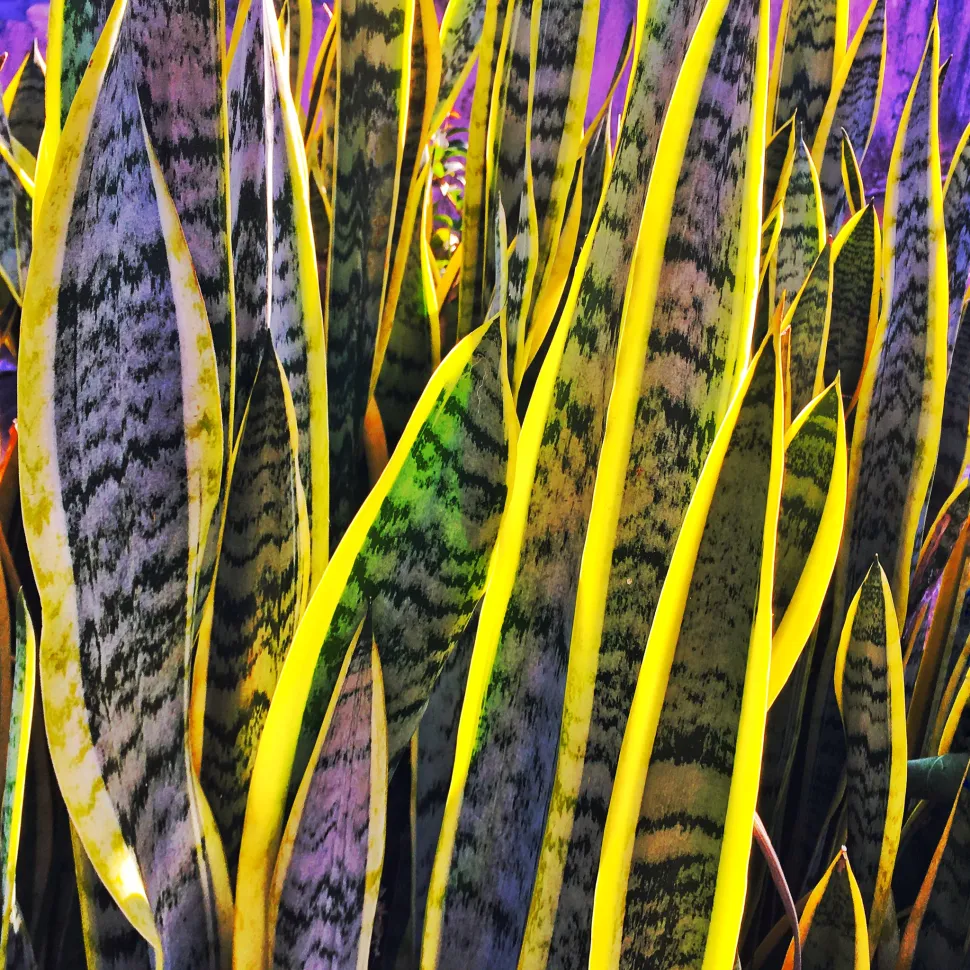
Finally, a plant with graphic foliage suitable for beginners - Photo by Carlos Ebert / Flickr
Seeing mother-in-law's tongues everywhere, you'd almost forget how graphic and designer these plants are. Their long green leaves with yellow margins bring color and verticality to bright spaces and dark corners alike.
Sansevieiria trifasciata is indestructible. It survives in the shade and with very little water. But that's no reason to neglect it! Download the Monstera app and follow our maintenance tips to ensure optimal growing conditions.
#4 Monstera variegata
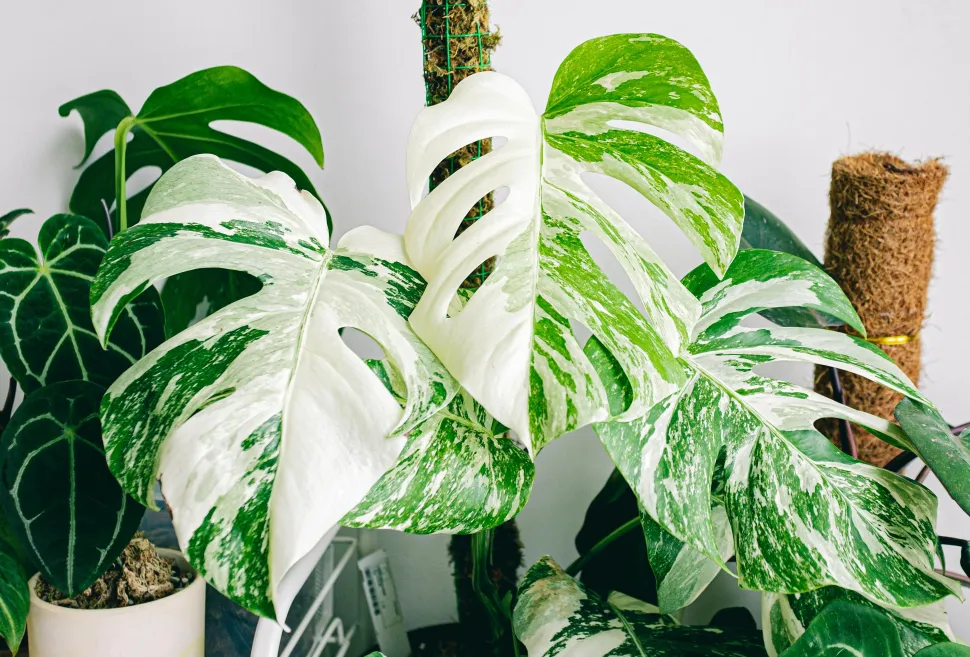
Classic yet timeless, the Monstera variegata continues to win fans - Photo by Huy Phans / Pexels
A classic of modern, minimalist interiors, Monstera deliciosa is available in an even more graphic foliage version: monstera deliciosa variegata. Its perforated green blades are marked by white variegations.
Over time, dust accumulates on the leaves. Clean them with a soft, clean, damp cloth. In this way, the plant will receive more light and you'll be able to take full advantage of its variegation.
#5 Alocasia cuprea
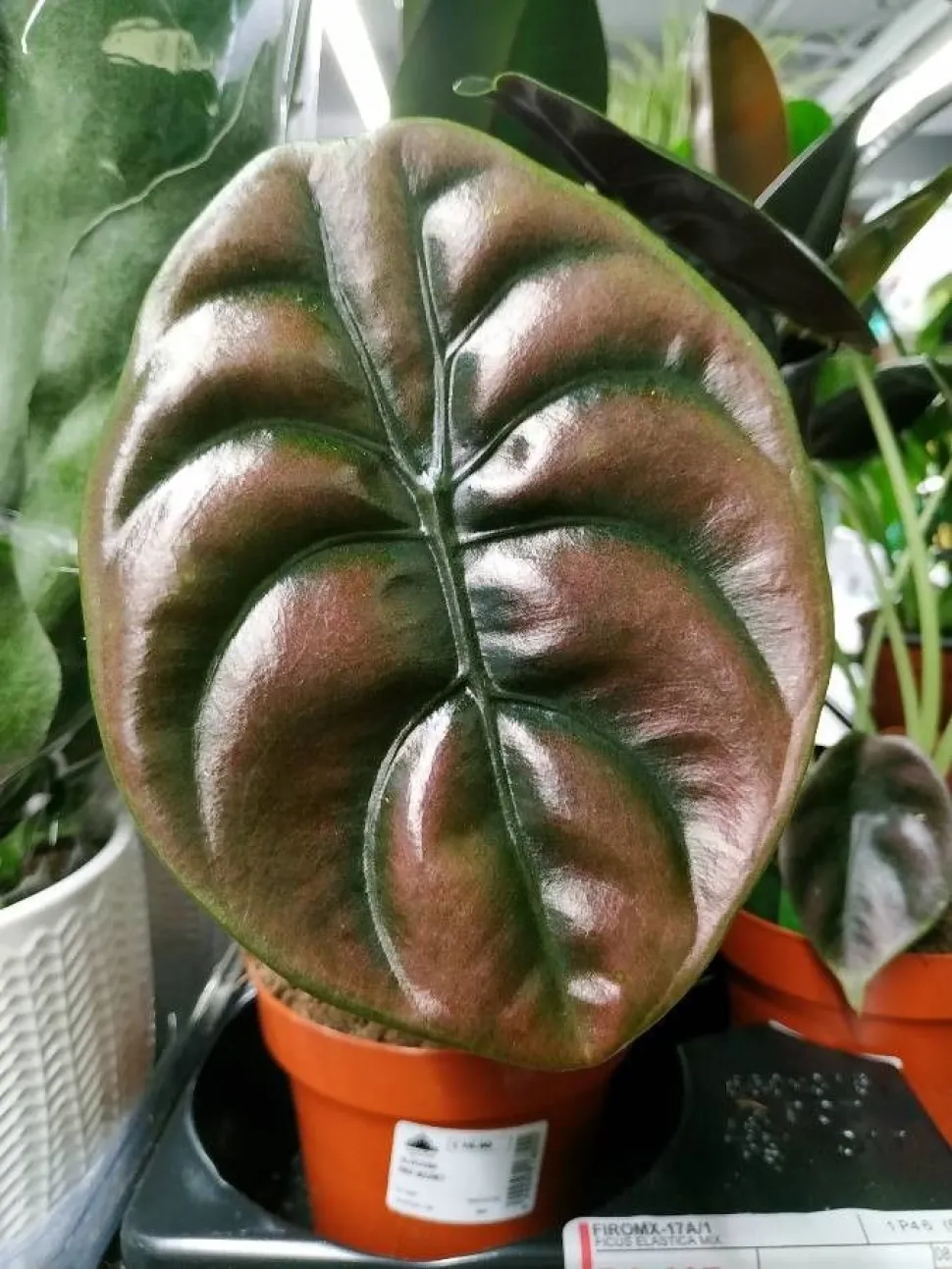
Growing an alocasia is no easy task, but it's well worth the effort - Photo by Sabine Issanchou / Plantnet
Alocasia cuprea's metallic limbs are a real eye-catcher. Bronze, copper or silver, they transform the plant into a sculpture with precious accents.
Alocasia should be reserved for experienced gardeners. They require the perfect balance of watering, humidity and sunlight. This variety appreciates indirect light for several hours a day in cooler weather. It will do best behind an east- or west-facing window, but not in the shade.
#6 Syngonium wendlandii
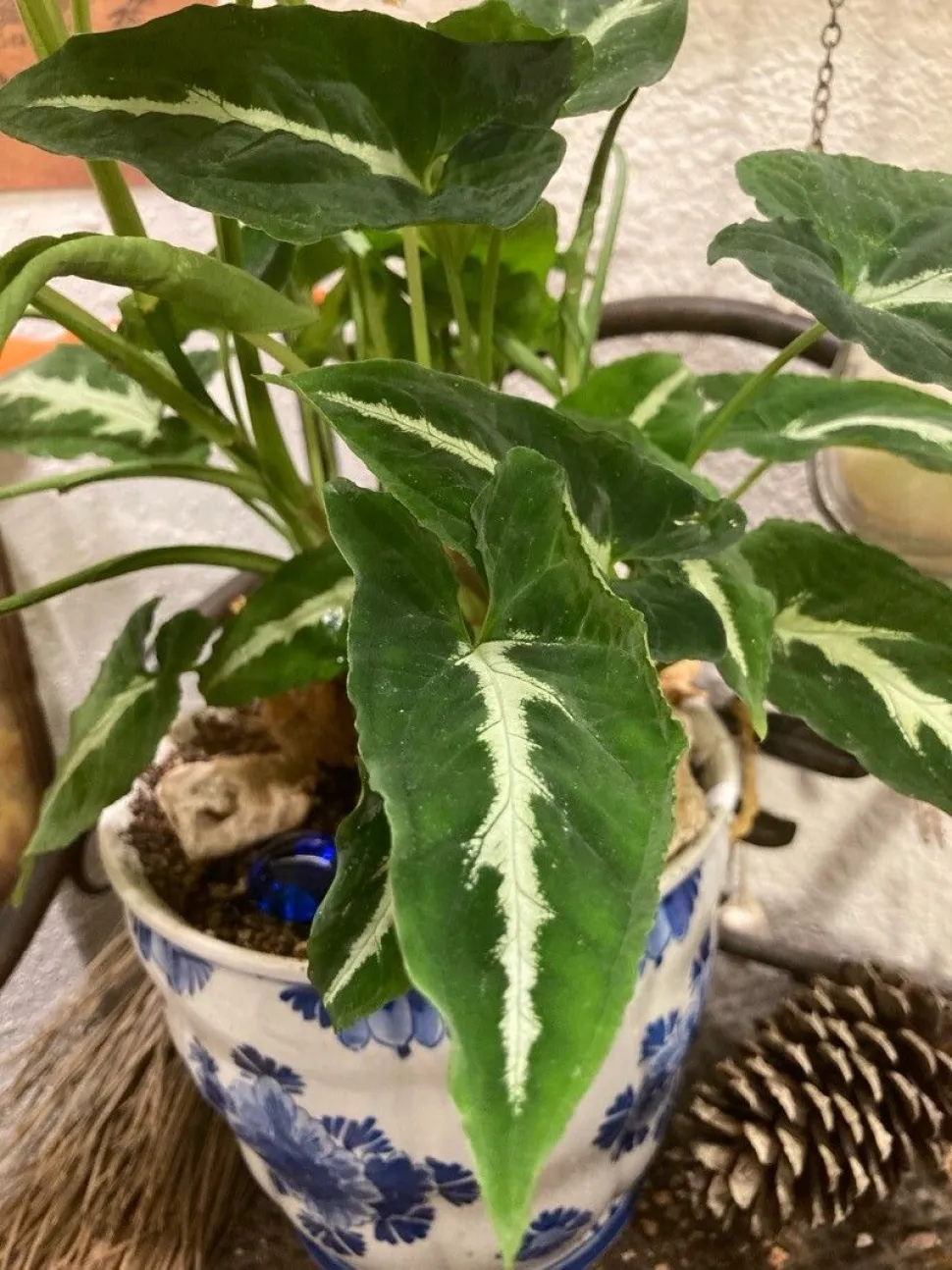
Syngonium wendlandii is like Alocasia for dummies - Photo by Djinn Rickey / Plantnet
For anyone who loves green leaves with white veins but can't keep an Alocasia alive, we've got the solution: Syngonium wendlandii. This climbing plant has velvety, bicolored leaf blades that are at least as spectacular.
However, syngonium wendlandii is much simpler to grow! It requires watering when the substrate is dry on the surface, but forgives oversights and excesses. As long as you don't overdo it!
#7 Calathea orbifolia (Goeppertia orbifolia)
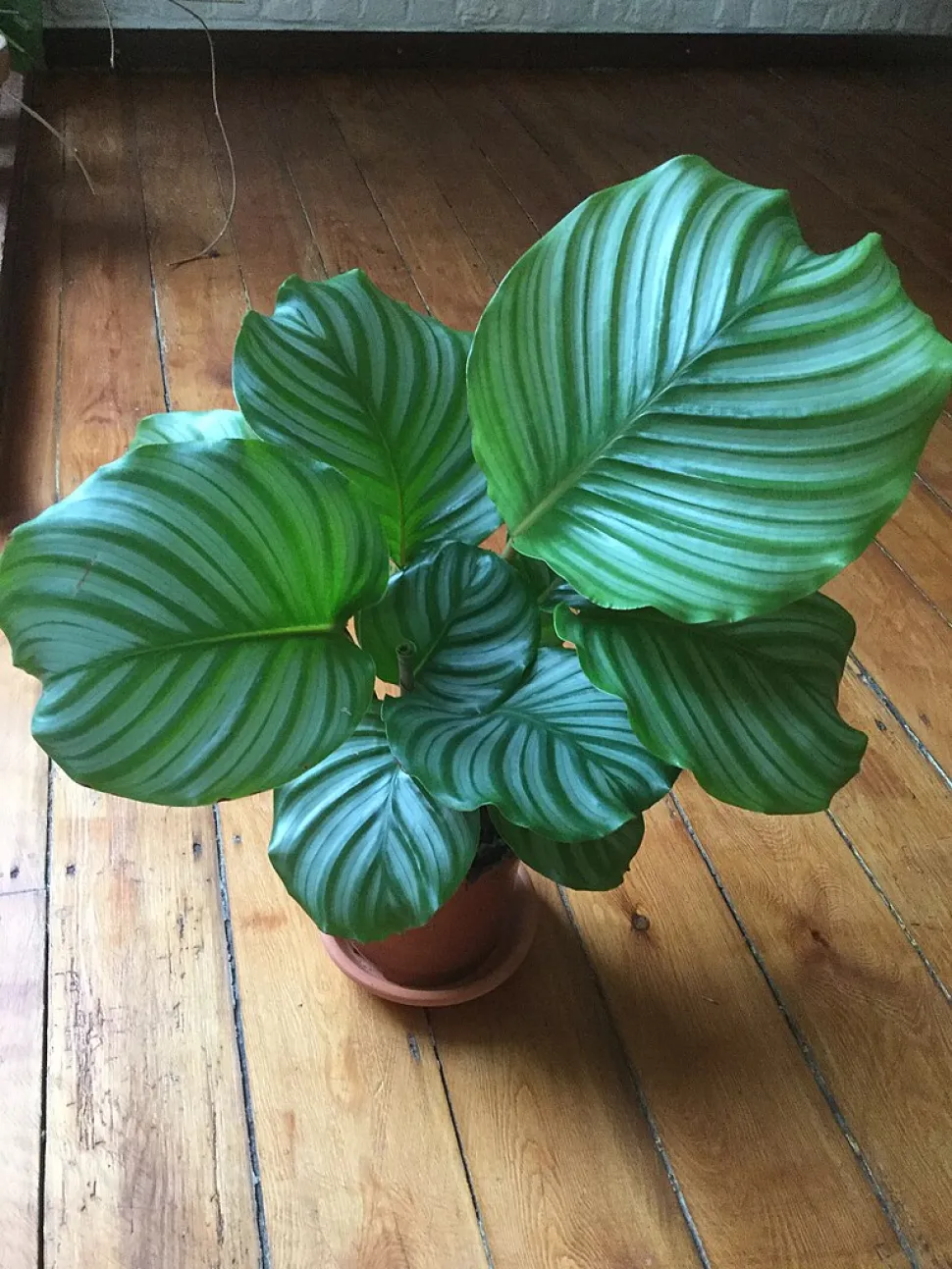
You don't need furniture when you've got a Calathea like this - Photo by Fregisseur / Wikipedia
The leaves of Calathea orbifolia measure up to 30 centimetres in diameter. Yet their size isn't the first thing you notice! Light green, they are accented by dark green, silvery streaks.
Goeppertia orbifolia is very slow-growing. If you want an impressive houseplant, buy a mature specimen.
#8 Philodendron 'Pink Princess
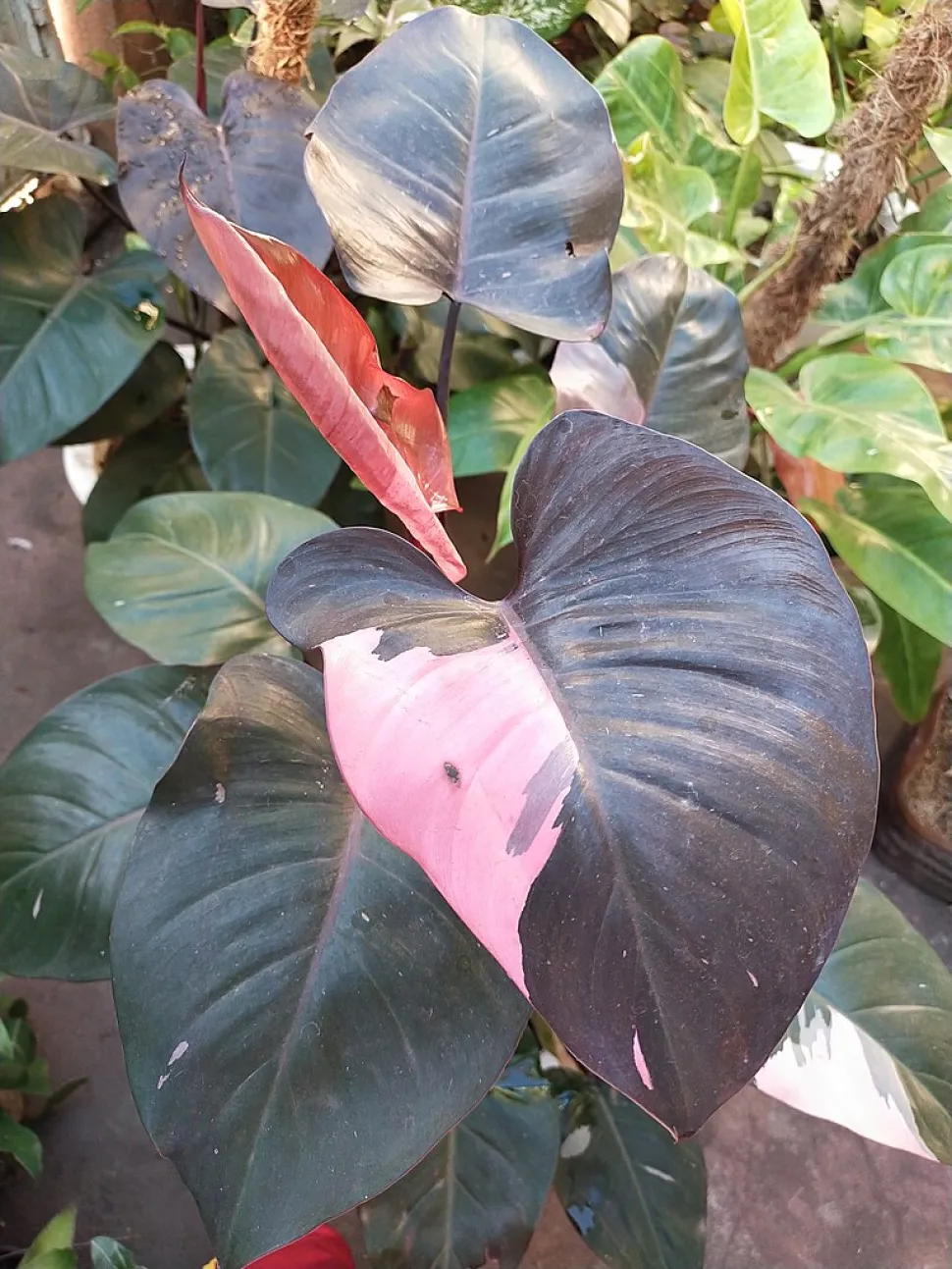
Philodendron 'Pink Princess' is a cross between Philo hastatum and Philo erubescens - Photo by Srikandi73 / Wikipedia
Each leaf of Philodendron 'Pink Princess' is unique. The pink and green that make them up give rise to a new pattern every time. Some blades are almost completely green with only a spot of pink, while others are mottled, zebra or two-tone.
Philodendron erubescens 'Pink Princess' vines grow to almost two meters long. They can be pruned in spring with clean pruning shears. Pinch the ends of the stems as well. This forces the plants to branch out and helps maintain a compact habit.
#9 Aglaonema commutatum
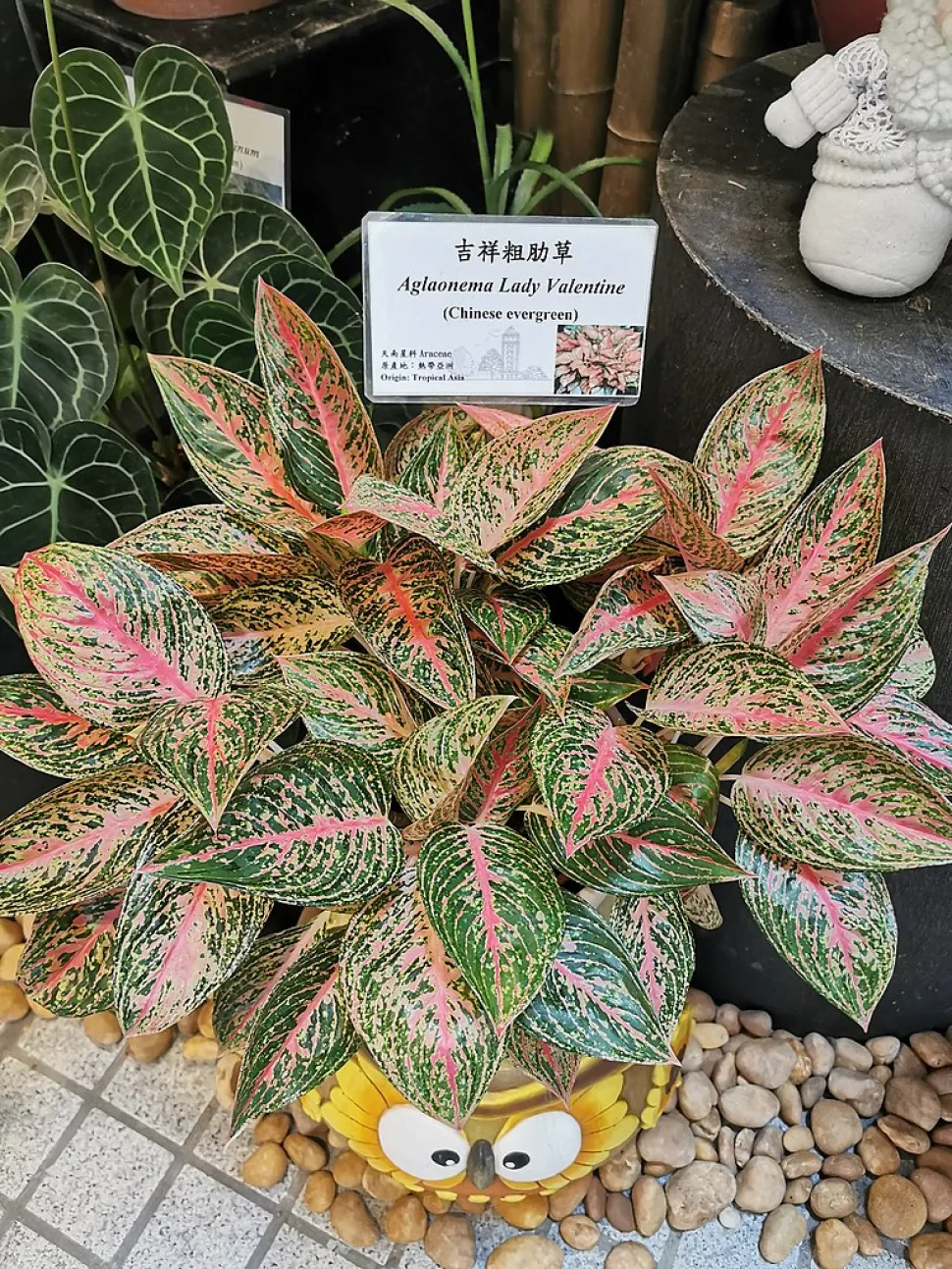
This variety is hard to find in stores, but you can get cuttings online - Photo by Ahmed / Wikipedia
With a look like this, it's no wonder that Aglaonema commutatum was chosen by Luc Besson to accompany the heroes of the film Léon. In the wild, this botanical variety sports green foliage. Some cultivars, however, go wild with pink or silver leaves. Our favorite? Aglaonema 'Lady Valentine', with its green limbs splashed with pink.
Graphic, easy to care for and suited to dark interiors... Aglaonema commutatum is almost the perfect plant! Its drawback? It is toxic to animals if ingested. Keep yours out of reach of your dog or cat.
#10 Calathea ornata (Goeppertia ornata)
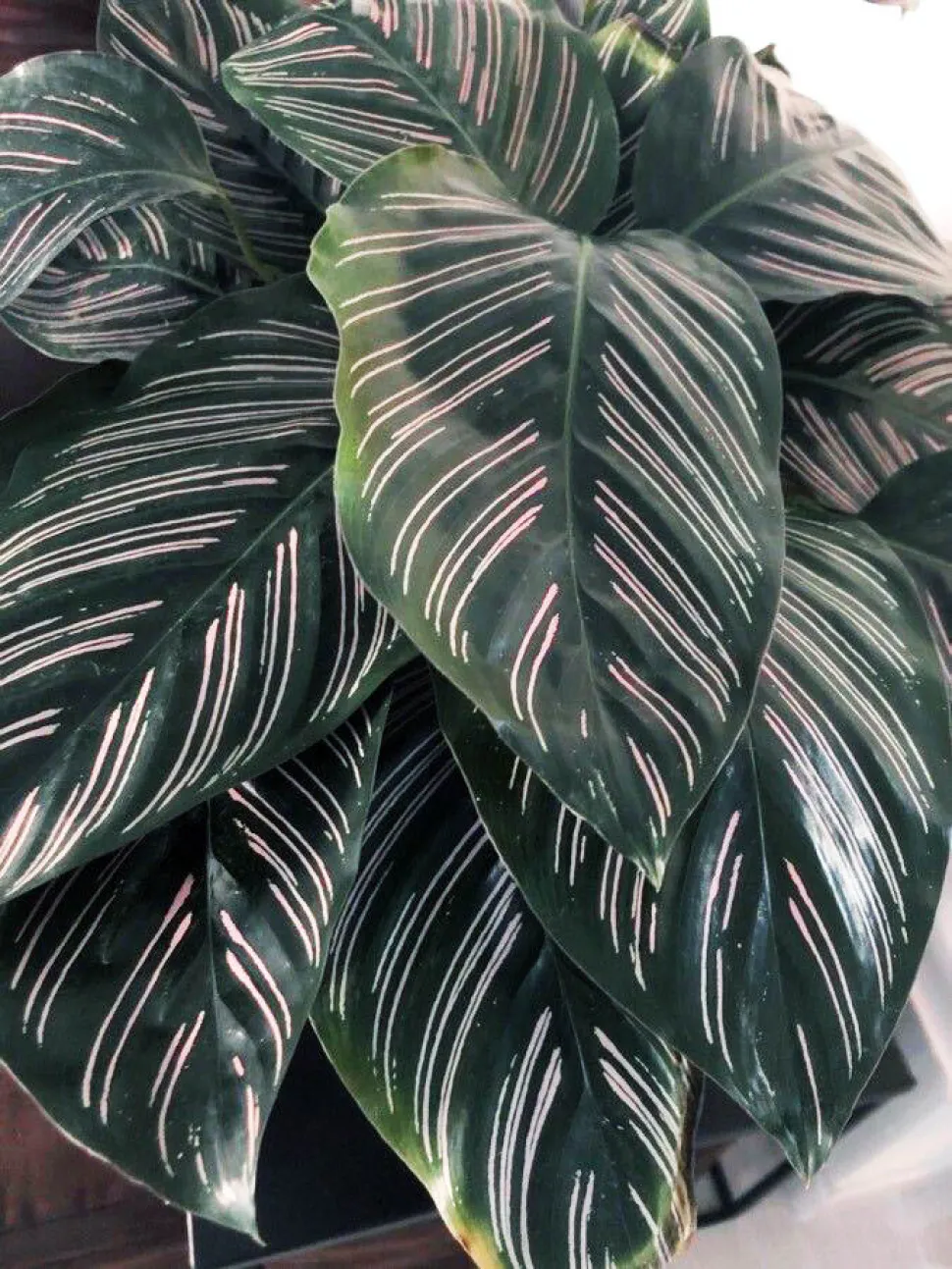
For a more discreet touch of pink, choose Calathea ornata... Photo by Philippe Pon / Plantnet
The delicate pale pink lines on the foliage of Calathea ornata look as if they've been painted by a patient and somewhat obsessive artist. They brighten up the deep green of the limbs.
Goeppertia ornata is a tropical variety, native to South American forests. It requires high humidity to thrive. You can mist it or, better still, place it in the shade of the other plants in your collection.
#11 Begonia maculata 'Wightii
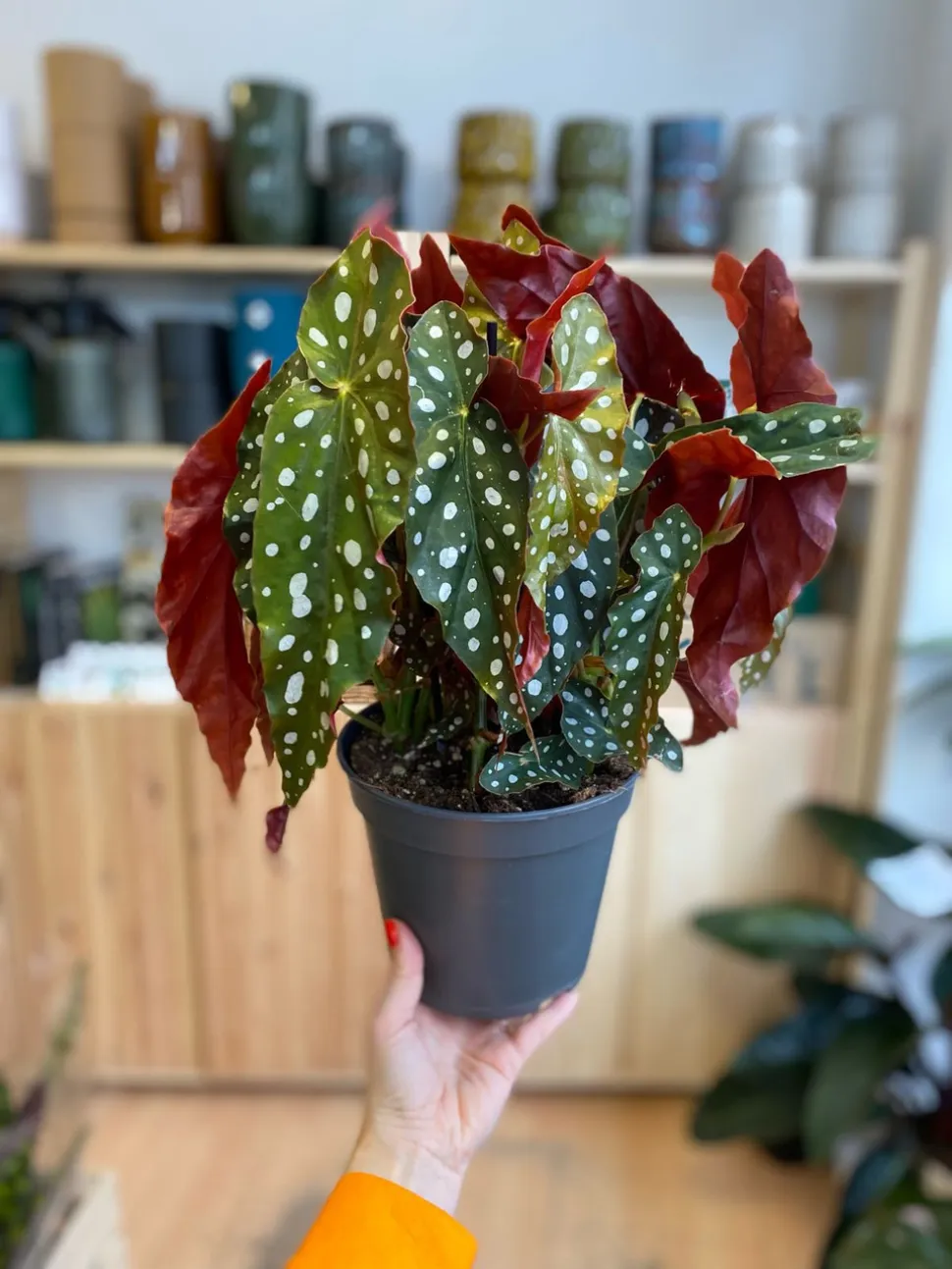
Dots make a welcome change from lines and variegation - Photo by H. Kewell / Wikipedia
Another plant that seems to have sprung straight from a painter's imagination: Begonia maculata 'Wightii'. Its green leaves studded with white or silver dots resemble a painting by Seurat or a work by Yayoi Kusama.
Indoors, Begonia maculata can be attacked by scale insects. If you spot any pests on your plant, remove them with a cotton bud soaked in alcohol.
#12 Anthurium clarinervium
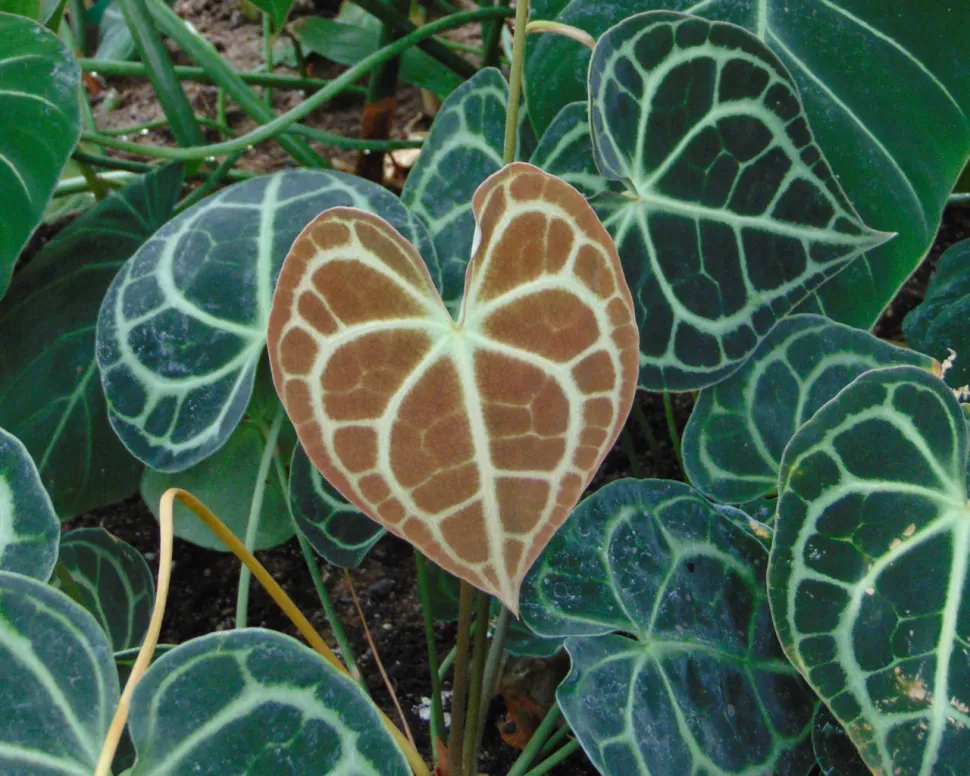
After a few weeks, the young blades lose their golden color and turn green - Photo by Nadiatalent / Wikipedia
This particular Anthurium is not grown for its flowers, but for its velvety, cordate foliage. If you marvel at its dark-green, sharply-veined leaves, you're in for a real treat. When they are born, the young blades are golden with white veins.
To encourage the growth of your Anthurium clarinervium, fertilize it with a green plant fertilizer between March and early autumn. Follow the manufacturer's recommended doses on the packaging to avoid damaging the foliage.
#13 Misery (Tradescantia zebrina)
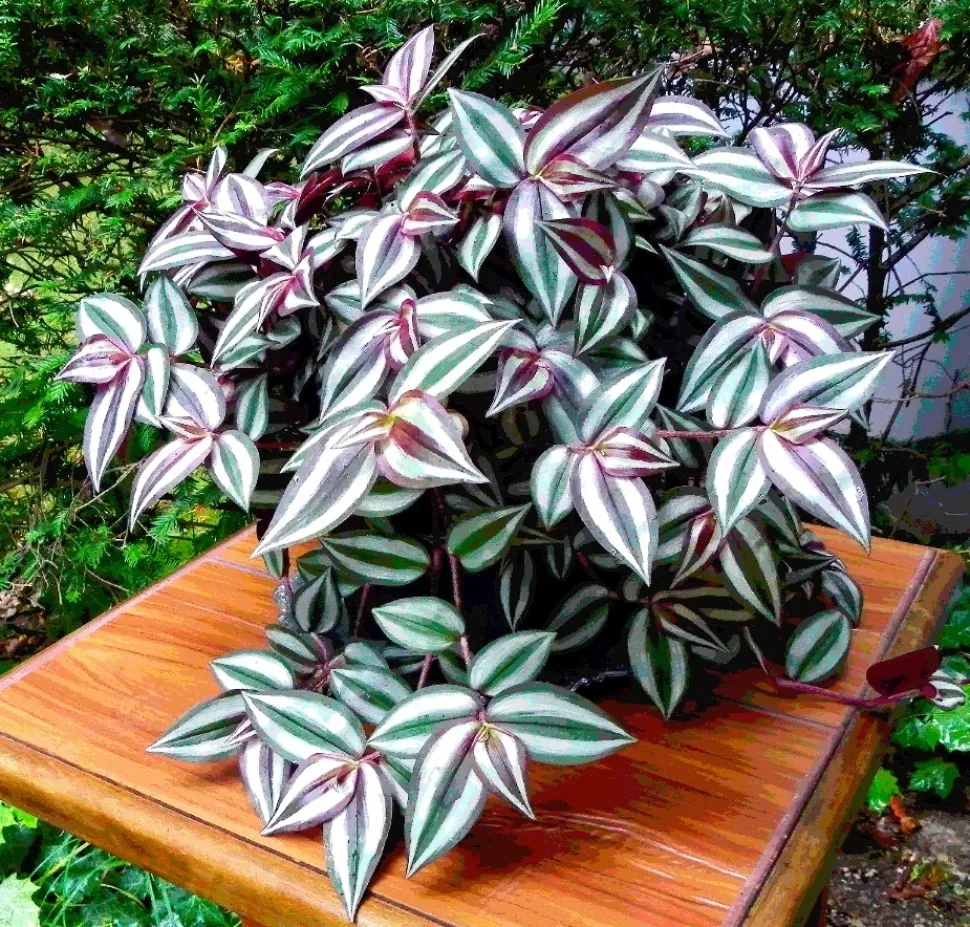
Whose idea was it to give such a beautiful plant such a sinister name? Photo by T. Voekler / Wikipedia
The foliage of Tradescantia zebrina combines color and pattern. Dark green and violet blades are criss-crossed with silver lines.
Tradescantia zebrina stems tend to wither over time. To maintain a well-stocked plant, renew it by taking cuttings. Simply cut off the end of a stem and replant it, either in the same pot or in a new one. It works every time, as long as you do it in spring and keep the soil moist.
#14 Cissus discolor
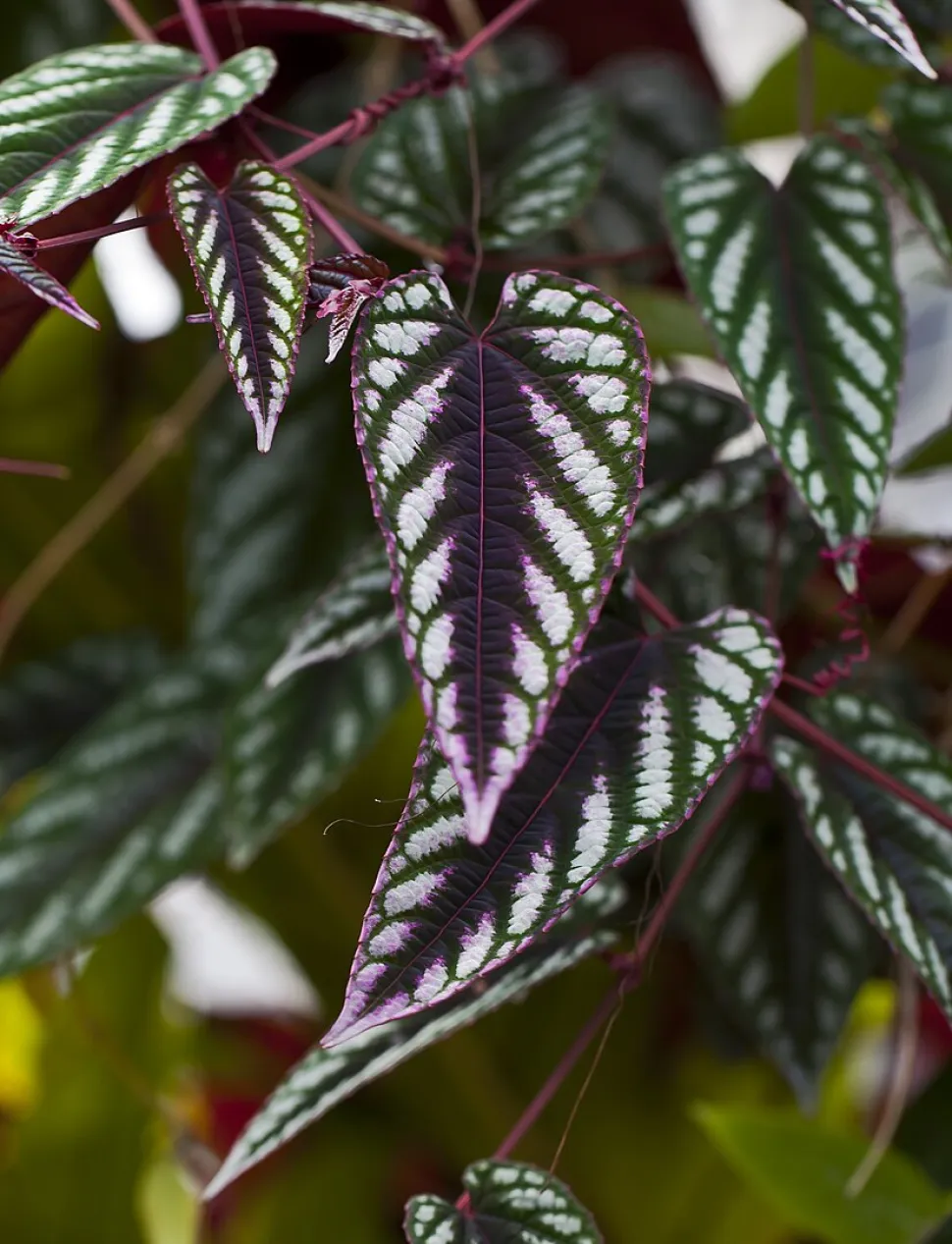
There's nothing like a little fluorescence to liven up green foliage - Photo by Diego Delso / Wikipedia
With its green limbs and silvery-purplereverse, Cissus discolor could easily be mistaken for a Calathea or Begonia rex. Not so. This plant, which we grow indoors, belongs to the Vitaceae family and comes to us from southern Asia.
Cissus discolor likes humid atmospheres, but not too much water. Place your creeper in your kitchen or bathroom and water only when the soil is thoroughly dry.
#15 Crassula 'Buddha's Temple
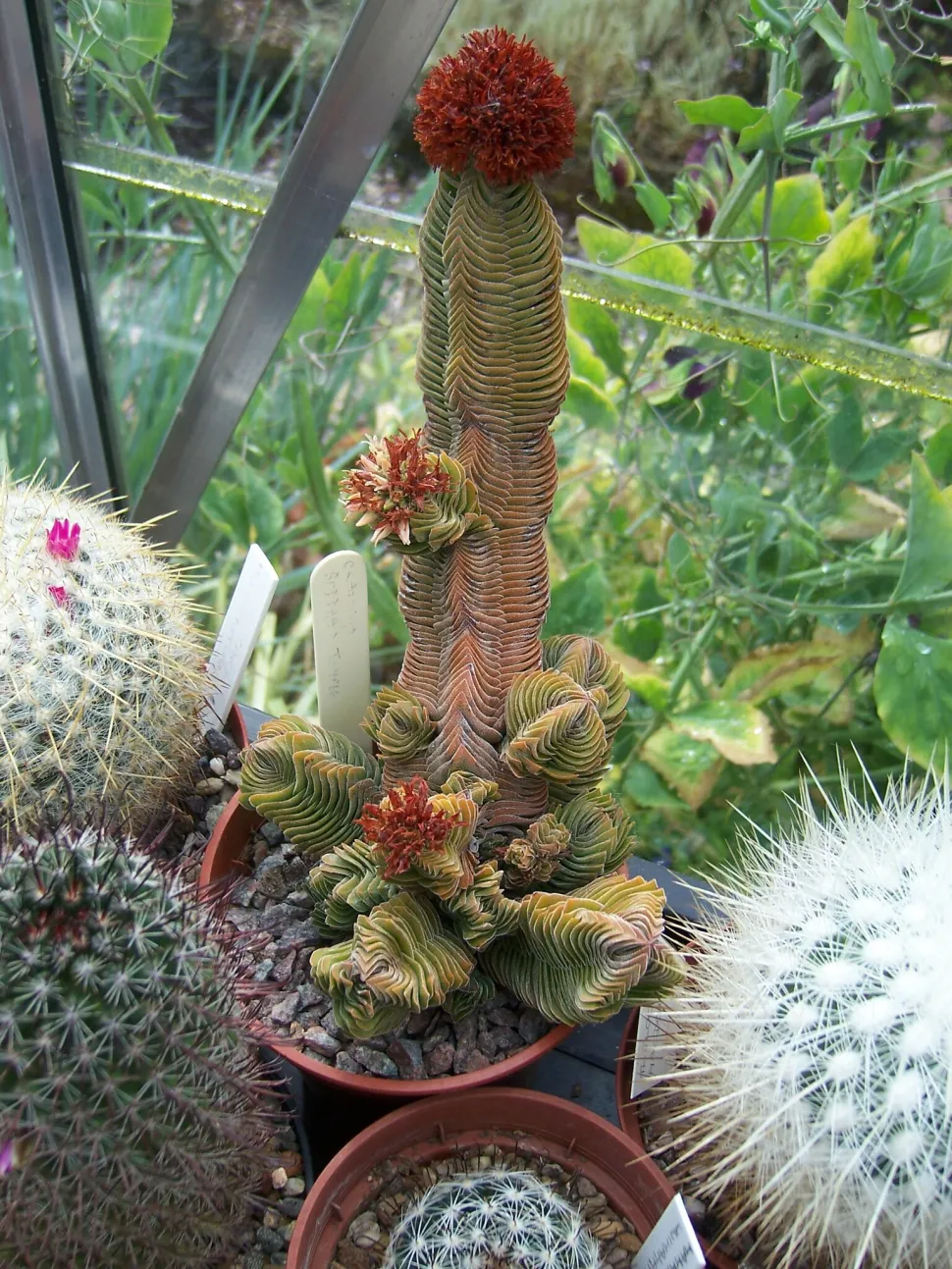
With flowers, Crassula 'Buddha's Temple' is even prettier - Photo by Stephen Boisvert/ Flickr
You can be a graphic plant and have monochrome foliage. The leaves of Crassula 'Buddha's Temple' are a plain green. But their arrangement makes them a curiosity. The leaf blades are interlocked, forming a geometric-looking column.
Your Crassula 'Buddha's Temple won't grow more than 30 centimetres high. Once mature, keep repotting it every two years in a pierced pot to provide it with new, nutrient-rich soil.
#16 Croton (Codiaeum variegatum)
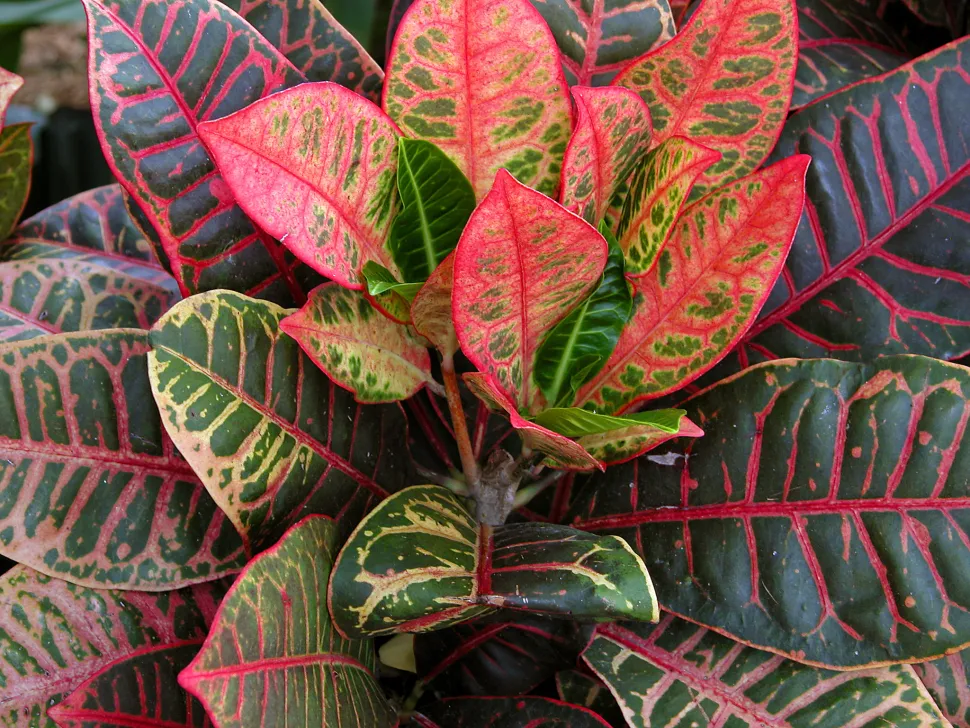
Why choose when you can have every color on the same foliage? Photo by Carl Lewis / Flickr
Graphic doesn't have to mean minimalist or uncluttered. If you want a colorful houseplant, get a Croton. Depending on the variety, you can choose from green, yellow, pink, orange and purple. Some leaves are a veritable rainbow, even combining all these shades.
In nature, crotons grow in tropical zones. Indoors, when the air is too dry, the leaves turn yellow and fall off. To prevent this, place your pot on a saucer filled with moist clay balls.
#17 Maranta leuconeura fascinator
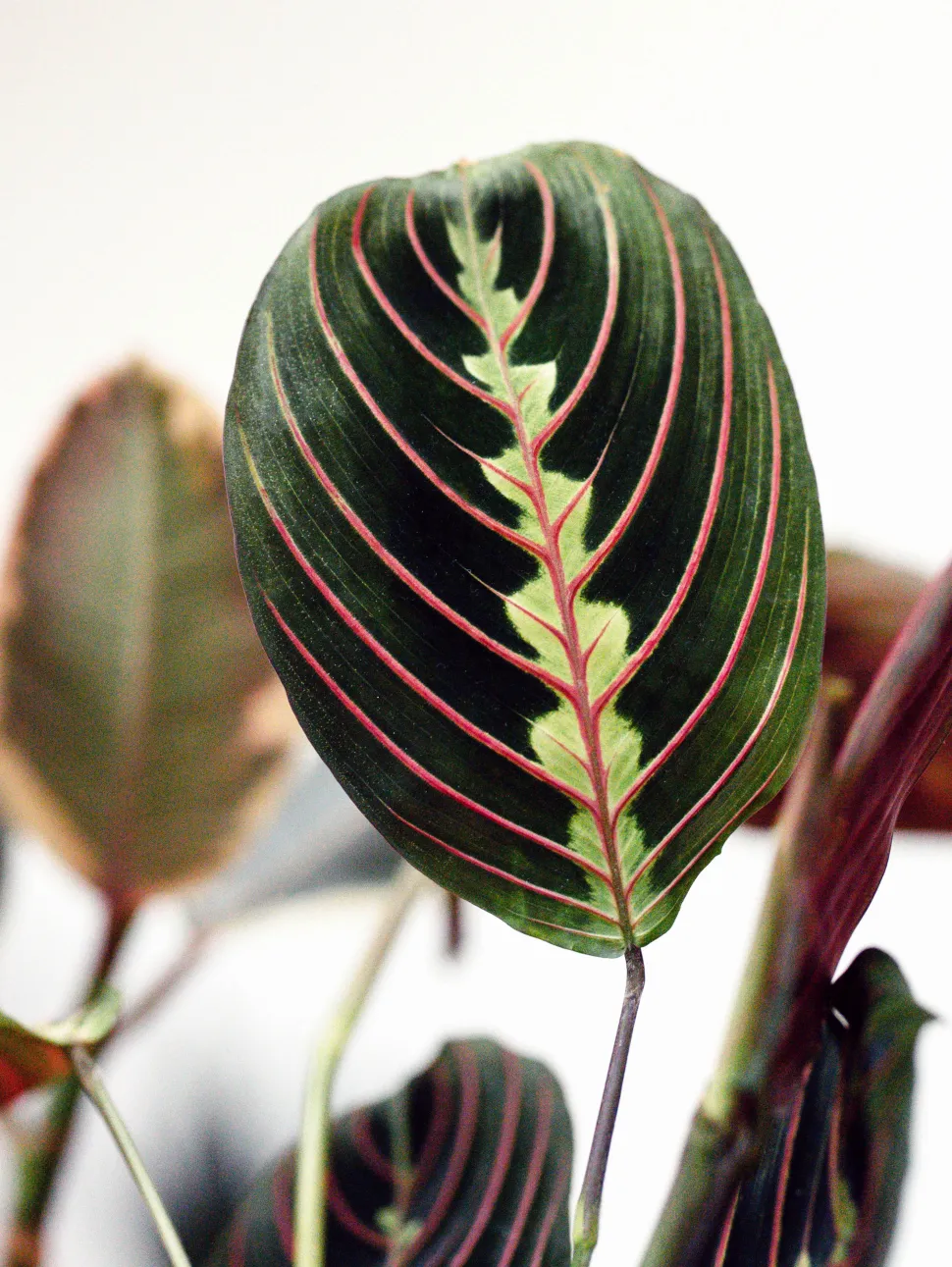
Marantas are no match for calatheas, and much easier to grow - Photo by Cottonbro studio / Pexels
There's something hypnotic about the foliage of the Maranta leuconeura fascinator. Once you've started to contemplate them, it's hard to take your eyes off these bright green leaves with their yellow and red lines.
Maranta leuconeura fascinator is a praying plant. Every evening, it folds up its limbs two by two, like hands clasped in prayer. In the morning, it unfolds them again.
#18 Ficus elastica 'Tineke
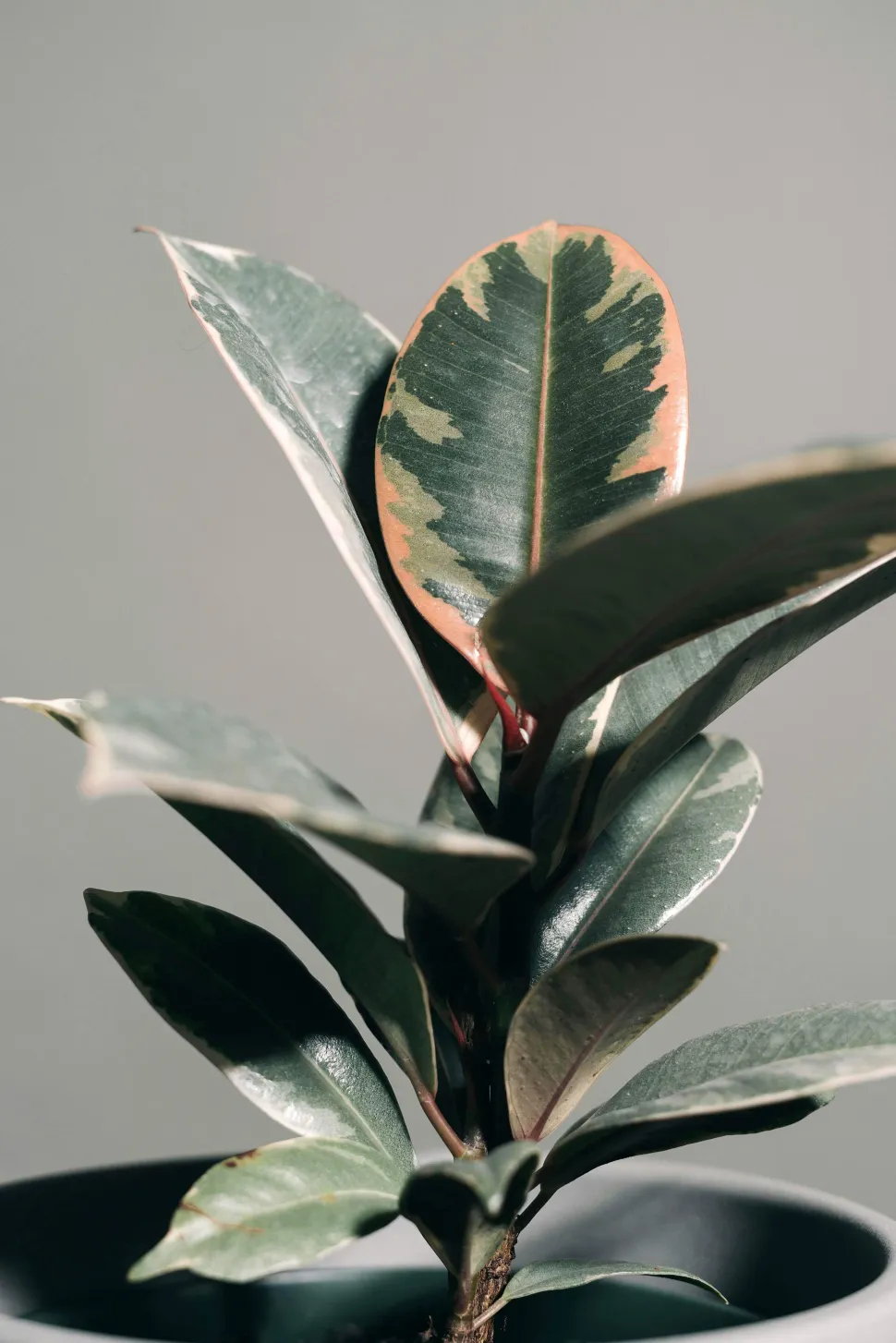
Each leaf of the Ficus elastica 'Tineke' has a unique pattern - Photo by Scott Webb / Pexels
Who can resist the green leaves enhanced with cream and pink of Ficus elastica 'Tineke' '? In just a few years, they've conquered our interiors as well as Pinterest boards.
Has your shrub lost a few leaves since you brought it home? It's perfectly normal. Like many plants, ficus hates change. Set yours up behind a window, away from draughts and direct sunlight. And don't move it again. The massacre should stop after a few days.
#19 Jewel orchid (Ludisia discolor)
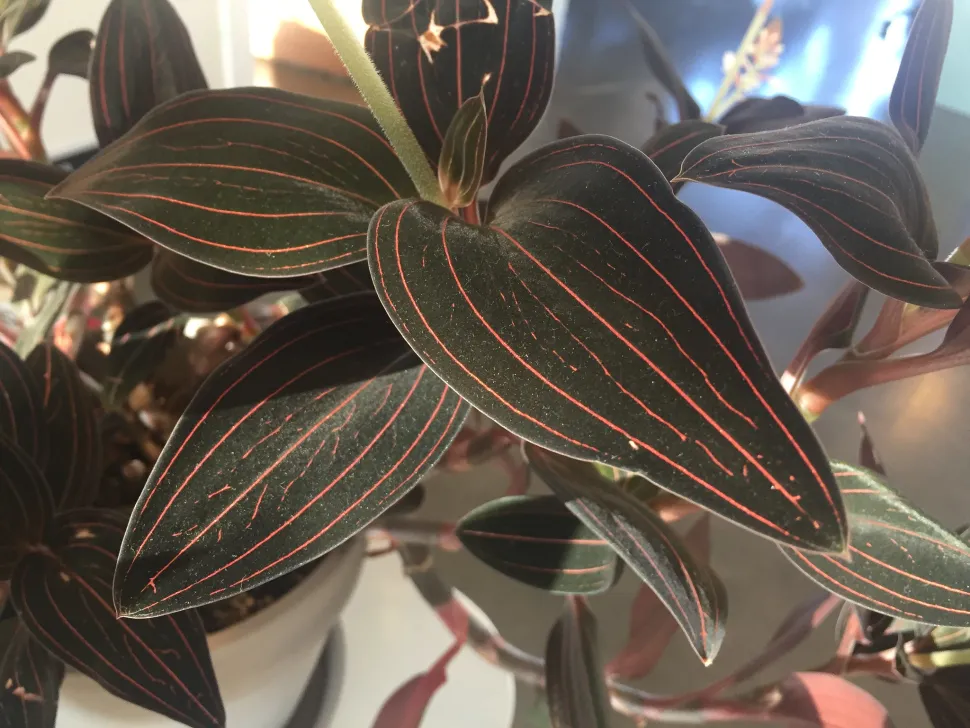
In the jewel orchid, the foliage is more spectacular than the flowers - Photo by Megan Hansen / Flickr
Ludisia discolor's white and yellow flowers look almost dull compared to its foliage. Pink, yellow, beige or orange veins run across its deep green or purple blades.
Ludisia discolor is a terrestrial orchid. It needs rich, well-drained soil. You can use potting soil for green plants with a little perlite. You can also prepare your own substrate by mixing peat moss, perlite, pine bark and leaf compost.
#20 Macodes petola
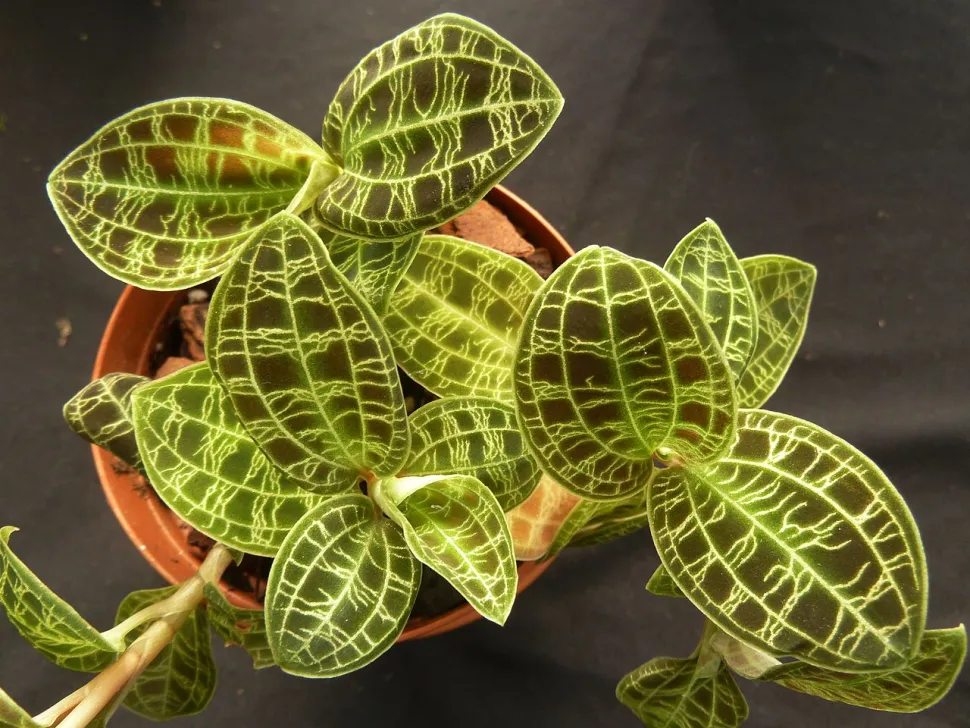
Macodes petola also belongs to the jewel orchid family - Photo by JMK / Wikipedia
Prefer emeralds to rubies? Macodes petola could be just what you're looking for. Its golden veins winding through bright green foliage give this jewel orchid a graphic, precious allure.
To stimulate foliage growth and flowering of your Macodes petola, add special orchid fertilizer to the watering solution in spring and summer.
#21 Peperomia clusiifolia
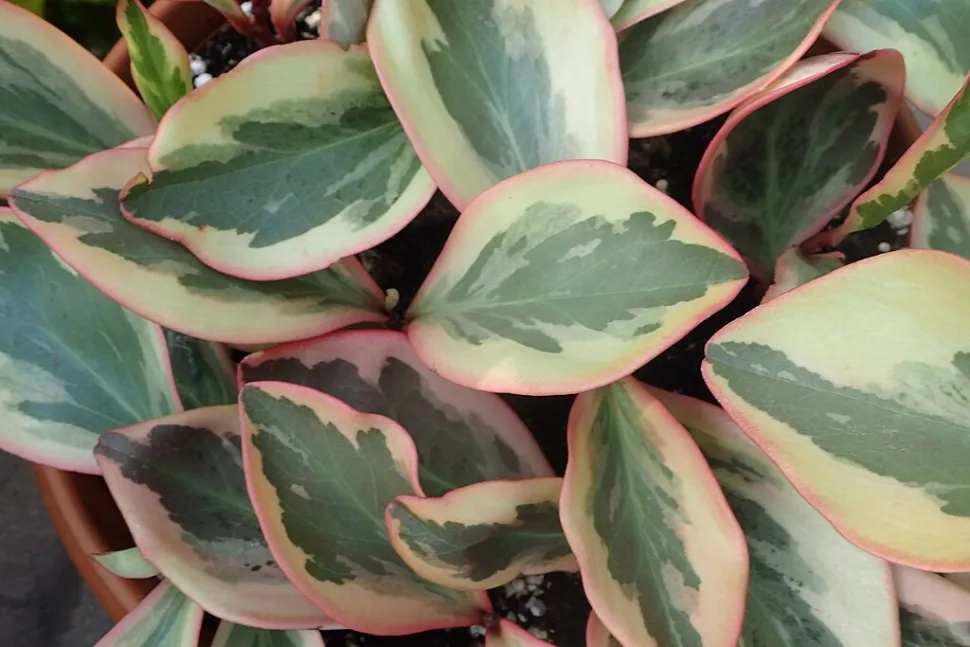
Peperomia clusiifolia 'Jelly' displays rather pastel shades - Photo by Krzysztof Ziarnek / Wikipedia
Think the plain dark-green leaves hemmed in dark red of Peperomia clusiifolia are too plain to feature in this selection of plants with graphic foliage? The 'Jelly', 'Ginny' and variegata varieties are sure to change your mind! In these cultivars, the leaf blades blend several shades of green, with a hint of cream and bright pink or pastel margins.
Peperomia clusiifolia is not hardy. In our latitudes, it is grown in pots and indoors. When the warm weather arrives, take your plant out onto your windowsill or into the garden. Just make sure you gradually get it used to the sun so as not to burn its leaves.
#22 The ephelid plant (Hypoestes phyllostachya)
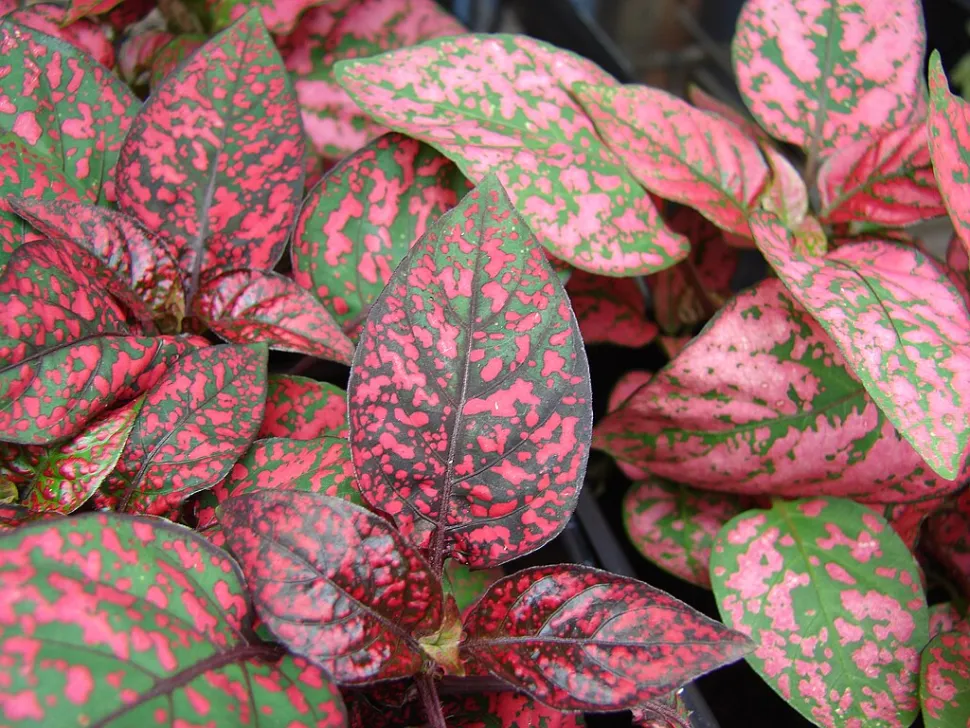
The color of Hypoestes phyllostachya's leaf blades and spots varies according to cultivar - Photo by Forest and Kim Starr / Wikipedia
Hypoestes phyllostachya is nicknamed the ephelid plant (the scientific name for freckles) because of the multitude of dots that adorn its pink, green or red leaves.
Hypoestes phyllostachya requires plenty of moisture. Don't hesitate to plant yours in a terrarium, to provide it with sufficient humidity.
#23 The ZZ Raven plant (Zamioculcas zamiifolia 'Raven')
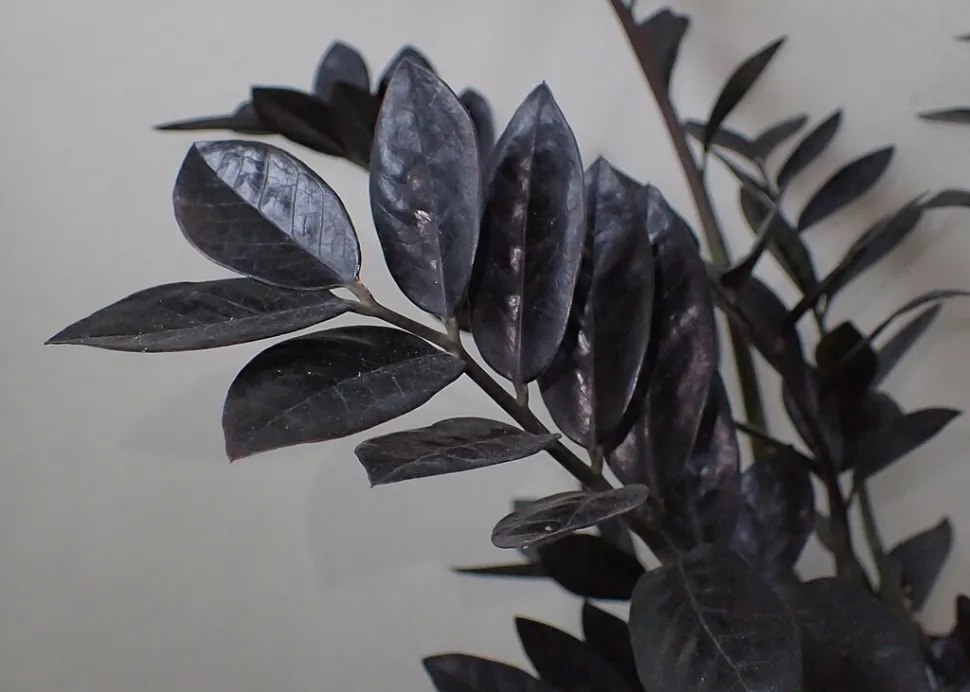
Rare are plants with such black foliage - Photo by Krzysztof Ziarnek / Wikipedia
If you've opted for a black and white decor, Zamioculcas zamiigolia 'Raven' is the plant for you. Its tough, dark-green, almost black leaves are equally at home in a Nordic living room or a Gothic bedroom.
Plant ZZ is a very hardy houseplant. It can, however, be invaded by mealybugs when the atmosphere becomes too humid. Remember to aerate regularly, especially in winter, to keep the air and environment dry.
#24 Pothos 'Néon' (Epipremnum aureum 'Néon')
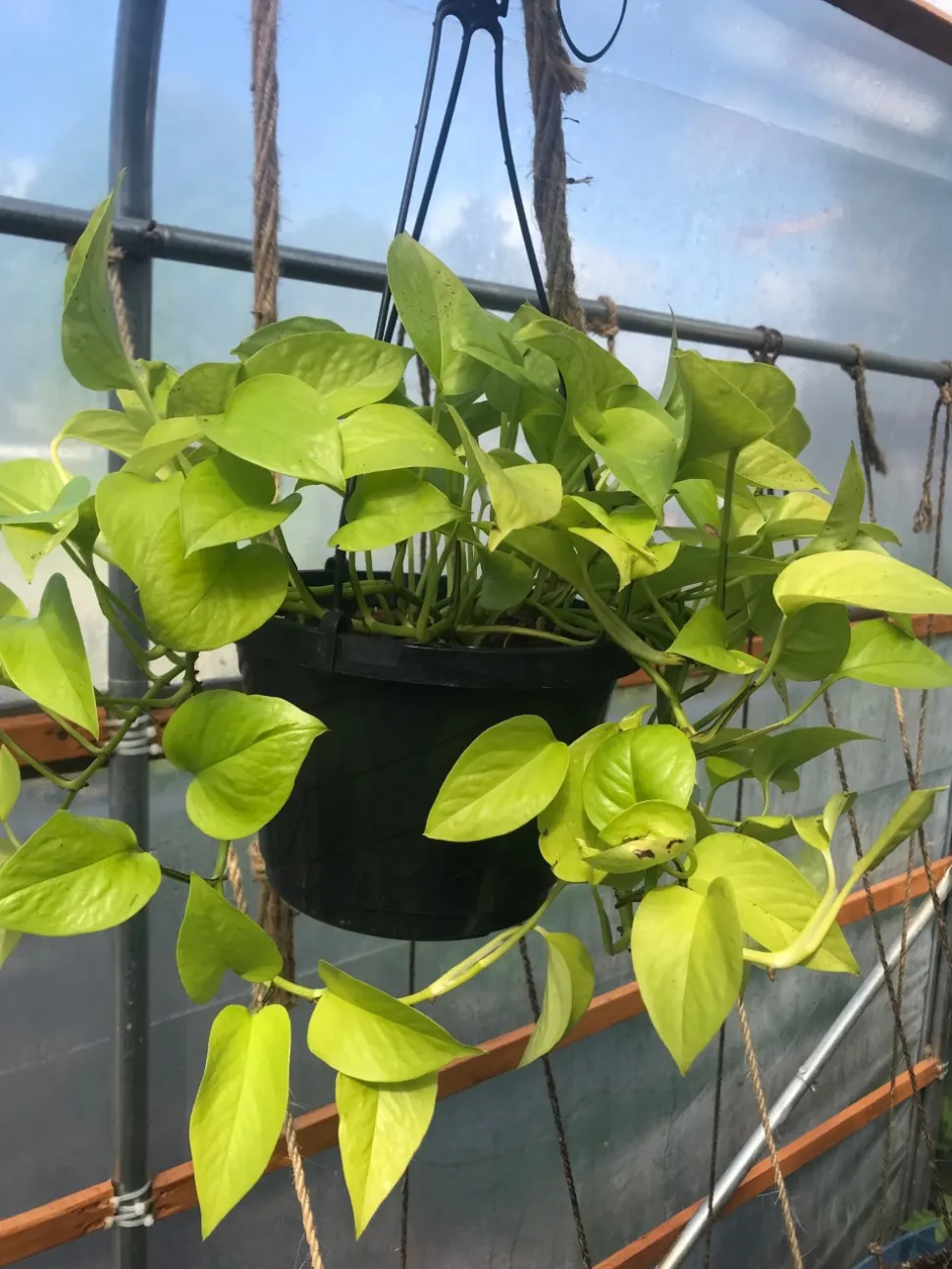
Easy to care for, pothos is ideal for beginners - Photo by Julien Gagné / Wikipedia
It's hard to choose which of all the Pothos varieties would join this list of plants with the best graphic foliage. We chose Pothos 'Neon' for its neon-yellow green leaves. Their color is enough to liven up any decor!
Pothos 'Neon can be grown as a hanging or climbing plant. Preferably use a stake lined with sphagnum moss. You'll be able to keep the moss moist and your creeper will cling more easily.
#25 False four-leaf clover (Oxalis tetraphylla)
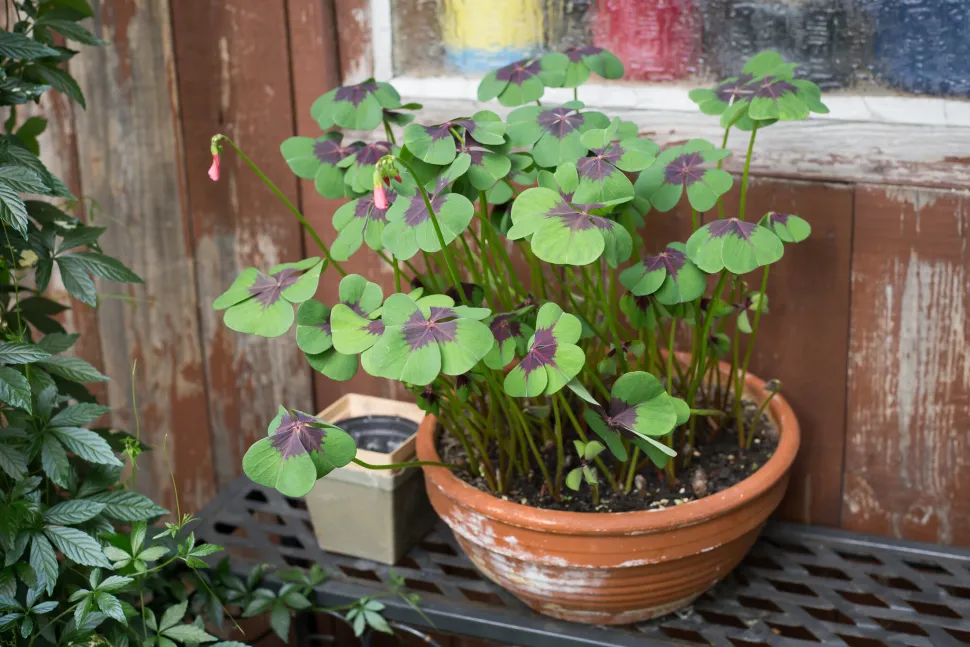
Oxalis tetraphylla blooms from May to July - Photo by Maja Dumat / Flickr
Oxalis tetraphylla may not bring you luck, but it will add a touch of elegance to your garden. Its four green leaflets, with a black or purple heart, can be grown as ground cover or in pots.
If you live in a region with mild winters, you can plant your Oxalis tetraphylla in the ground. Outside the orange-growing zone, plant it in pots so that you can put it outside in summer and bring it inside in summer.
#26 Schefflera actinophylla (Heptapleurum actinophyllum)
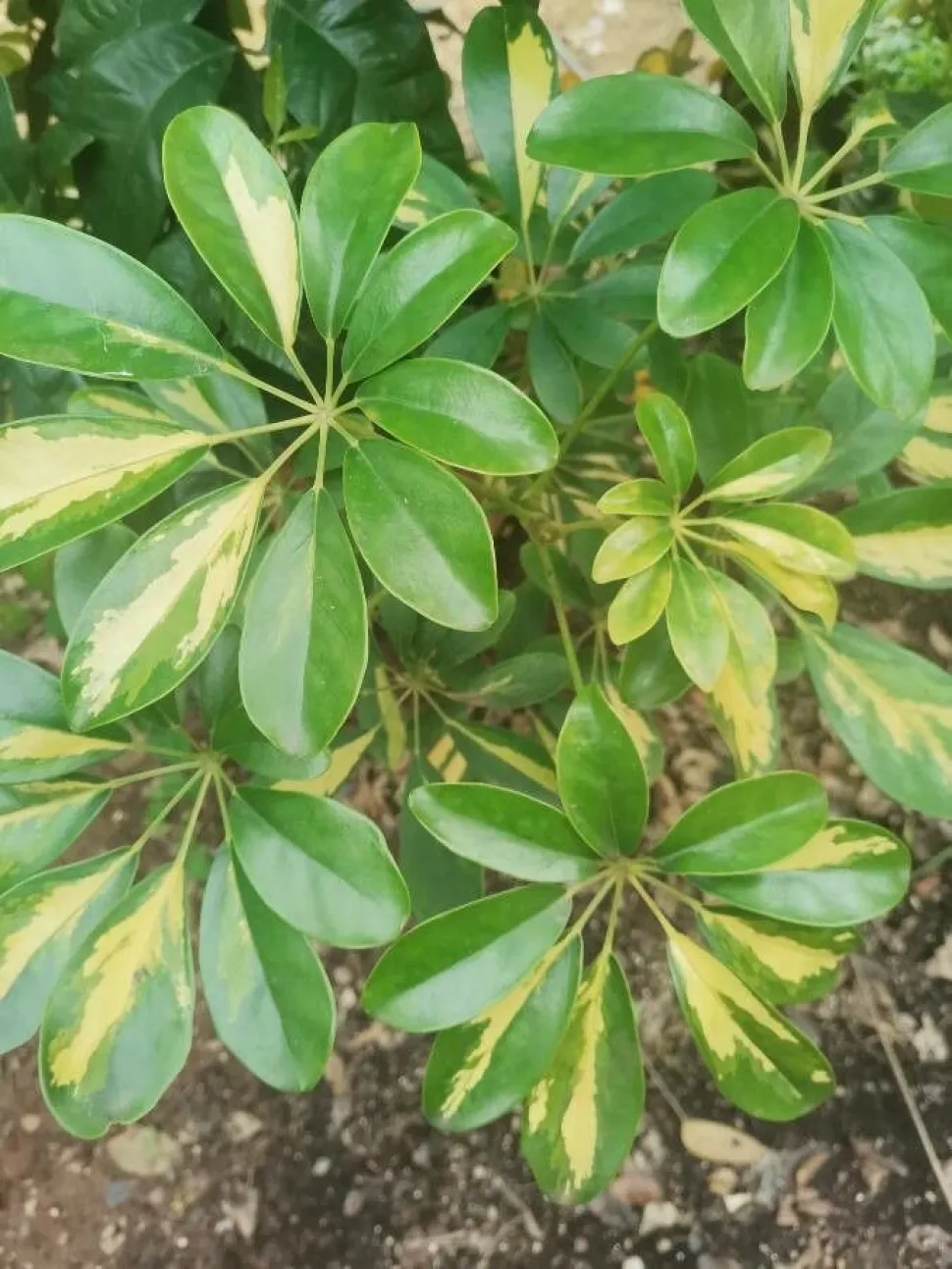
Some varieties feature variegated foliage - Photo by Juan Jose Peña / Plantnet
If you need to dress up a large space, adopt a Heptapleurum actinophyllum. This shrub grows up to two meters high in pots. Already very graphic in its botanical version, with a single trunk and plain green palmate leaves, the umbrella tree is even more remarkable when it has a woven trunk and yellow-edged limbs.
After a few years, your shrub will be too imposing to repot. However, you can renew the substrate every year by resurfacing it. Remove a third of the soil and replace it with potting soil for green plants, enriched with a little peat and sand.
#27 Florist's asparagus (Asparagus setaceus)
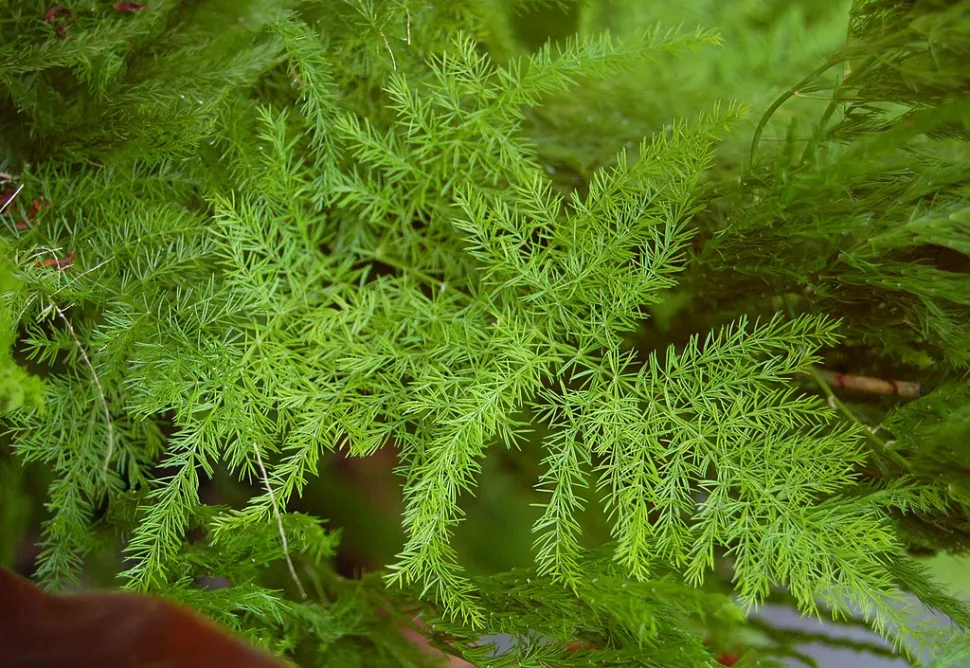
The cladodes look like leaves but are actually branches - Photo by Ram Man / Wikipedia
At first glance, the plain green foliage of Asparagus setaceus is nothing out of the ordinary. But as you get closer, you realize that it's made up of thousands of acid-green cladodes, just a few millimeters long.
Asparagus setaceus doesn't like limestone. When watering, use rainwater rather than tap water. Make sure the water is at room temperature, to avoid stressing the roots.
By Servane Nemetz
on 22-08-2024 at 09h53
on 22-08-2024 at 09h53



